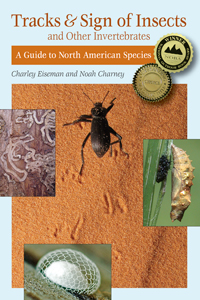By far the most common question I’m asked when I identify an insect for someone is, “is it a good bug or a bad bug?” I usually don’t give a straight answer. Maybe this post will help illustrate why. For the last couple of years the magnolia bush in my yard was covered with magnolia scales, something most people would not hesitate to call “bad” bugs. The whole plant was sticky with their honeydew and covered with the black sooty mold that grows on it. This year there isn’t a scale to be seen, and I have to say I’m missing them.
Why? Because all kinds of interesting insects (many of which happen to be “good” bugs, since they’re pollinators) were attracted to the sweet honeydew, and now there’s barely anything going on there, apart from some Phyllocnistis leaf mines and the sorts of things you’ll find on any kind of plant, just by random chance. Here’s a sampling of what the scale insects’ honeydew was attracting:

Sweat bee (Halictidae: Lasioglossum cressonii), loaded with pollen. This species nests in rotten wood.

One of the square-headed wasps in the tribe Crabronini, which, depending on what species it is, either digs holes in the ground or uses preexisting cavities to provision with a particular type of insect, paralyzed, for its larvae to feed on. [4/16/2013 edit: Matthias Buck has identified this as an Ectemnius, species of which nest in twigs or wood borings and provision their nests with flies.]

A thread-waisted wasp in the genus Isodontia; it may be I. mexicana, which stuffs paralyzed tree crickets into preexisting cavities and plugs them up with grass, again as food for its larvae.

Strangalia famelica famelica, a longhorned beetle whose larvae develop in rotting wood of oak, chestnut, and birch.

A thick-headed fly (Conopidae: Physocephala). These may have been sipping some honeydew, but I mainly saw them lurking on the undersides of the leaves, where they were likely waiting for a bee to jump on. These flies lay eggs in bumble bees while in flight, and their larvae are internal parasites.
There were other things, like various hover flies (Syrphidae) whose larvae are aphid predators, but you get the idea. Why there are no scale insects this year, I’m not sure, but there were an awful lot of twice-stabbed lady beetles, which specialize in eating scale insects, on the magnolia bush last year. I never actually got a picture of one on the magnolia; the ones shown here were among hundreds that were congregating on some scale-infested beech trees this spring.
This pair is illustrating my answer to the second most frequently asked question I get about insects, which is “what is its purpose?” Its purpose, as with any living thing, is to make more of whatever it is.
A final note: The abundance of scale insects over the past few years had no adverse effect on the magnolia’s bloom. In fact, rather than just having an ephemeral burst of flowers in the spring, the bush bloomed all summer, as it has continued to do this year. I wonder if this might be a response to stress caused by the scale insects, but this is pure speculation.









A nice reminder of why we need a diversity of life, and why it is not a good idea to divide up nature into good guys and bad guys.
Great diversity post Charley! Did you happen to collect the Platypezid (I know it’s usually a choice between picture and collection ;)) If so we have a student starting her M.Sc. on Platypezid systematics who would love to receive any specimens she can!
Sorry, I didn’t… the only insects I collect are the ones that emerge from galls, leaf mines, etc. that I’m trying to identify. If any platypezids happen to emerge from fungi I collect, though, I’ll save them for her!
Great thanks, I’m sure sure any specimens with associated rearing records would be even more intersting for her!
Fascinating look at my own backyard! I love that magnolia and had no idea so many pretty creatures were lurking in the mold. : )
It would be great f our blogs could help people understand that interesting can be so much better than just decorative and pretty.
Fantastic post! My yard this past summer had similar drama, especially at night. I even took a similar shot of mating twice-stabbed lady beetles. They must be the exhibitionists of the beetle world.
Pingback: The Yard List(s), Part 14 | BugTracks